Walter Quattrociocchi
Decoding AI Judgment: How LLMs Assess News Credibility and Bias
Feb 06, 2025



Abstract:Large Language Models (LLMs) are increasingly used to assess news credibility, yet little is known about how they make these judgments. While prior research has examined political bias in LLM outputs or their potential for automated fact-checking, their internal evaluation processes remain largely unexamined. Understanding how LLMs assess credibility provides insights into AI behavior and how credibility is structured and applied in large-scale language models. This study benchmarks the reliability and political classifications of state-of-the-art LLMs - Gemini 1.5 Flash (Google), GPT-4o mini (OpenAI), and LLaMA 3.1 (Meta) - against structured, expert-driven rating systems such as NewsGuard and Media Bias Fact Check. Beyond assessing classification performance, we analyze the linguistic markers that shape LLM decisions, identifying which words and concepts drive their evaluations. We uncover patterns in how LLMs associate credibility with specific linguistic features by examining keyword frequency, contextual determinants, and rank distributions. Beyond static classification, we introduce a framework in which LLMs refine their credibility assessments by retrieving external information, querying other models, and adapting their responses. This allows us to investigate whether their assessments reflect structured reasoning or rely primarily on prior learned associations.
Decoding Musical Evolution Through Network Science
Jan 13, 2025



Abstract:Music has always been central to human culture, reflecting and shaping traditions, emotions, and societal changes. Technological advancements have transformed how music is created and consumed, influencing tastes and the music itself. In this study, we use Network Science to analyze musical complexity. Drawing on $\approx20,000$ MIDI files across six macro-genres spanning nearly four centuries, we represent each composition as a weighted directed network to study its structural properties. Our results show that Classical and Jazz compositions have higher complexity and melodic diversity than recently developed genres. However, a temporal analysis reveals a trend toward simplification, with even Classical and Jazz nearing the complexity levels of modern genres. This study highlights how digital tools and streaming platforms shape musical evolution, fostering new genres while driving homogenization and simplicity.
Online Hate: Behavioural Dynamics and Relationship with Misinformation
May 28, 2021


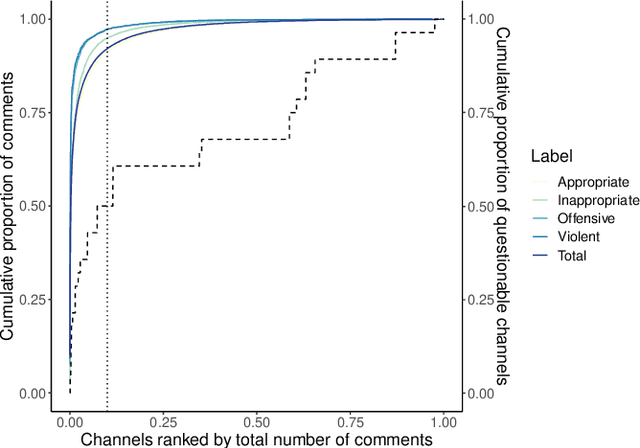
Abstract:Online debates are often characterised by extreme polarisation and heated discussions among users. The presence of hate speech online is becoming increasingly problematic, making necessary the development of appropriate countermeasures. In this work, we perform hate speech detection on a corpus of more than one million comments on YouTube videos through a machine learning model fine-tuned on a large set of hand-annotated data. Our analysis shows that there is no evidence of the presence of "serial haters", intended as active users posting exclusively hateful comments. Moreover, coherently with the echo chamber hypothesis, we find that users skewed towards one of the two categories of video channels (questionable, reliable) are more prone to use inappropriate, violent, or hateful language within their opponents community. Interestingly, users loyal to reliable sources use on average a more toxic language than their counterpart. Finally, we find that the overall toxicity of the discussion increases with its length, measured both in terms of number of comments and time. Our results show that, coherently with Godwin's law, online debates tend to degenerate towards increasingly toxic exchanges of views.
RTbust: Exploiting Temporal Patterns for Botnet Detection on Twitter
Feb 12, 2019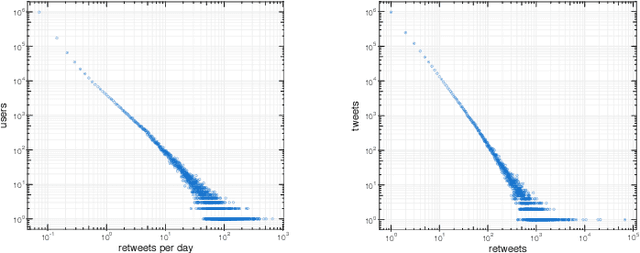

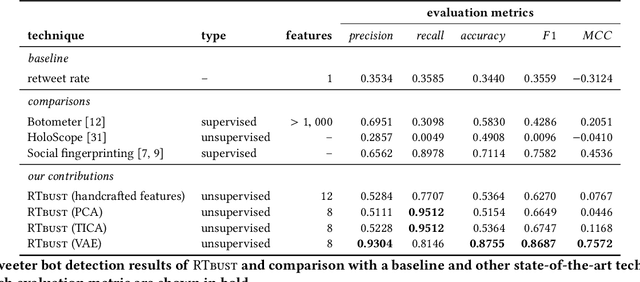
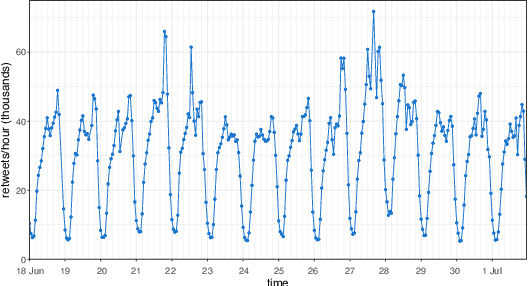
Abstract:Within OSNs, many of our supposedly online friends may instead be fake accounts called social bots, part of large groups that purposely re-share targeted content. Here, we study retweeting behaviors on Twitter, with the ultimate goal of detecting retweeting social bots. We collect a dataset of 10M retweets. We design a novel visualization that we leverage to highlight benign and malicious patterns of retweeting activity. In this way, we uncover a 'normal' retweeting pattern that is peculiar of human-operated accounts, and 3 suspicious patterns related to bot activities. Then, we propose a bot detection technique that stems from the previous exploration of retweeting behaviors. Our technique, called Retweet-Buster (RTbust), leverages unsupervised feature extraction and clustering. An LSTM autoencoder converts the retweet time series into compact and informative latent feature vectors, which are then clustered with a hierarchical density-based algorithm. Accounts belonging to large clusters characterized by malicious retweeting patterns are labeled as bots. RTbust obtains excellent detection results, with F1 = 0.87, whereas competitors achieve F1 < 0.76. Finally, we apply RTbust to a large dataset of retweets, uncovering 2 previously unknown active botnets with hundreds of accounts.
Exploiting Reputation in Distributed Virtual Environments
Jun 25, 2011



Abstract:The cognitive research on reputation has shown several interesting properties that can improve both the quality of services and the security in distributed electronic environments. In this paper, the impact of reputation on decision-making under scarcity of information will be shown. First, a cognitive theory of reputation will be presented, then a selection of simulation experimental results from different studies will be discussed. Such results concern the benefits of reputation when agents need to find out good sellers in a virtual market-place under uncertainty and informational cheating.
Understanding opinions. A cognitive and formal account
Jun 21, 2011Abstract:The study of opinions, their formation and change, is one of the defining topics addressed by social psychology, but in recent years other disciplines, as computer science and complexity, have addressed this challenge. Despite the flourishing of different models and theories in both fields, several key questions still remain unanswered. The aim of this paper is to challenge the current theories on opinion by putting forward a cognitively grounded model where opinions are described as specific mental representations whose main properties are put forward. A comparison with reputation will be also presented.
Rooting opinions in the minds: a cognitive model and a formal account of opinions and their dynamics
Jun 21, 2011Abstract:The study of opinions, their formation and change, is one of the defining topics addressed by social psychology, but in recent years other disciplines, like computer science and complexity, have tried to deal with this issue. Despite the flourishing of different models and theories in both fields, several key questions still remain unanswered. The understanding of how opinions change and the way they are affected by social influence are challenging issues requiring a thorough analysis of opinion per se but also of the way in which they travel between agents' minds and are modulated by these exchanges. To account for the two-faceted nature of opinions, which are mental entities undergoing complex social processes, we outline a preliminary model in which a cognitive theory of opinions is put forward and it is paired with a formal description of them and of their spreading among minds. Furthermore, investigating social influence also implies the necessity to account for the way in which people change their minds, as a consequence of interacting with other people, and the need to explain the higher or lower persistence of such changes.
Opinions within Media, Power and Gossip
Feb 11, 2011
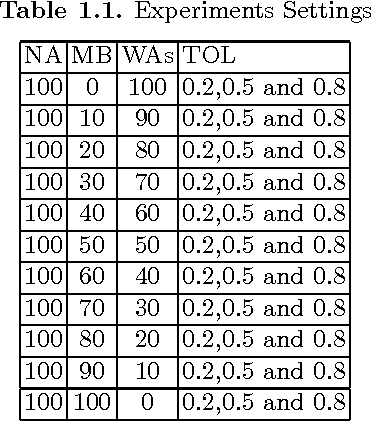

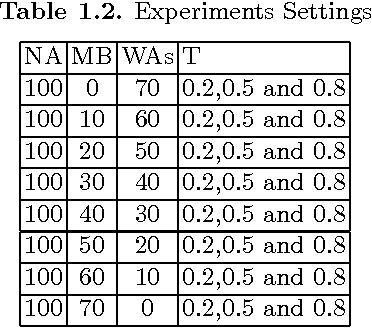
Abstract:Despite the increasing diffusion of the Internet technology, TV remains the principal medium of communication. People's perceptions, knowledge, beliefs and opinions about matter of facts get (in)formed through the information reported on by the mass-media. However, a single source of information (and consensus) could be a potential cause of anomalies in the structure and evolution of a society. Hence, as the information available (and the way it is reported) is fundamental for our perceptions and opinions, the definition of conditions allowing for a good information to be disseminated is a pressing challenge. In this paper starting from a report on the last Italian political campaign in 2008, we derive a socio-cognitive computational model of opinion dynamics where agents get informed by different sources of information. Then, a what-if analysis, performed trough simulations on the model's parameters space, is shown. In particular, the scenario implemented includes three main streams of information acquisition, differing in both the contents and the perceived reliability of the messages spread. Agents' internal opinion is updated either by accessing one of the information sources, namely media and experts, or by exchanging information with one another. They are also endowed with cognitive mechanisms to accept, reject or partially consider the acquired information.
Time-Varying Graphs and Social Network Analysis: Temporal Indicators and Metrics
Feb 03, 2011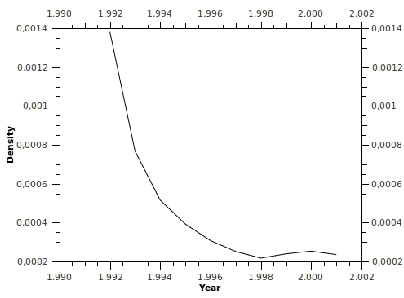
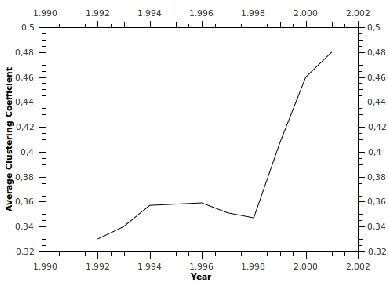
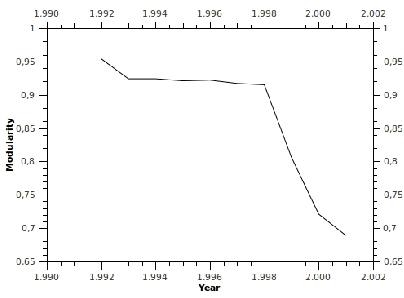
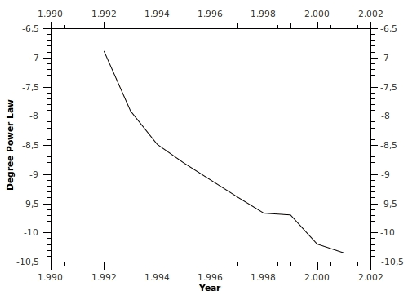
Abstract:Most instruments - formalisms, concepts, and metrics - for social networks analysis fail to capture their dynamics. Typical systems exhibit different scales of dynamics, ranging from the fine-grain dynamics of interactions (which recently led researchers to consider temporal versions of distance, connectivity, and related indicators), to the evolution of network properties over longer periods of time. This paper proposes a general approach to study that evolution for both atemporal and temporal indicators, based respectively on sequences of static graphs and sequences of time-varying graphs that cover successive time-windows. All the concepts and indicators, some of which are new, are expressed using a time-varying graph formalism.
Emergence through Selection: The Evolution of a Scientific Challenge
Feb 01, 2011
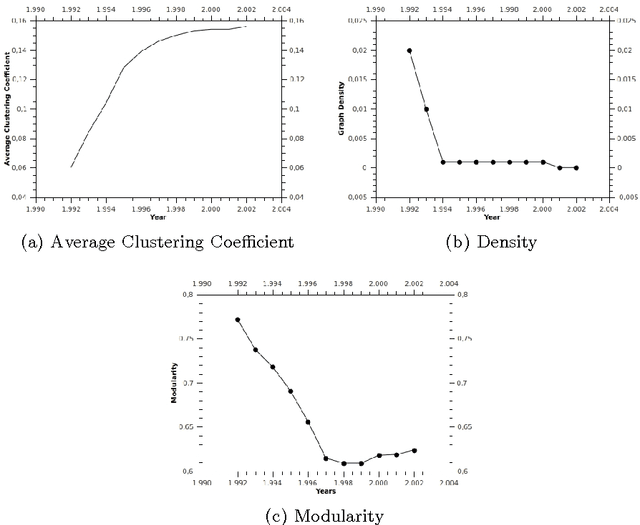
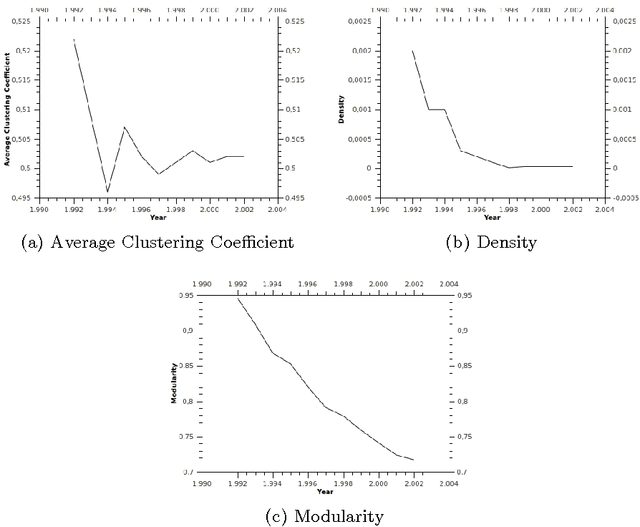
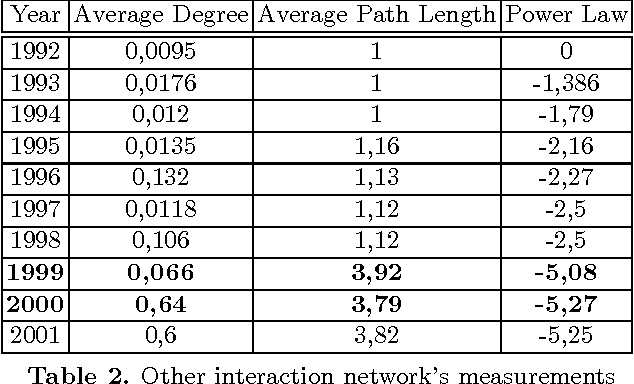
Abstract:One of the most interesting scientific challenges nowadays deals with the analysis and the understanding of complex networks' dynamics and how their processes lead to emergence according to the interactions among their components. In this paper we approach the definition of new methodologies for the visualization and the exploration of the dynamics at play in real dynamic social networks. We present a recently introduced formalism called TVG (for time-varying graphs), which was initially developed to model and analyze highly-dynamic and infrastructure-less communication networks such as mobile ad-hoc networks, wireless sensor networks, or vehicular networks. We discuss its applicability to complex networks in general, and social networks in particular, by showing how it enables the specification and analysis of complex dynamic phenomena in terms of temporal interactions, and allows to easily switch the perspective between local and global dynamics. As an example, we chose the case of scientific communities by analyzing portion of the ArXiv repository (ten years of publications in physics) focusing on the social determinants (e.g. goals and potential interactions among individuals) behind the emergence and the resilience of scientific communities. We consider that scientific communities are at the same time communities of practice (through co-authorship) and that they exist also as representations in the scientists' mind, since references to other scientists' works is not merely an objective link to a relevant work, but it reveals social objects that one manipulates, select and refers to. In the paper we show the emergence/selection of a community as a goal-driven preferential attachment toward a set of authors among which there are some key scientists (Nobel prizes).
 Add to Chrome
Add to Chrome Add to Firefox
Add to Firefox Add to Edge
Add to Edge